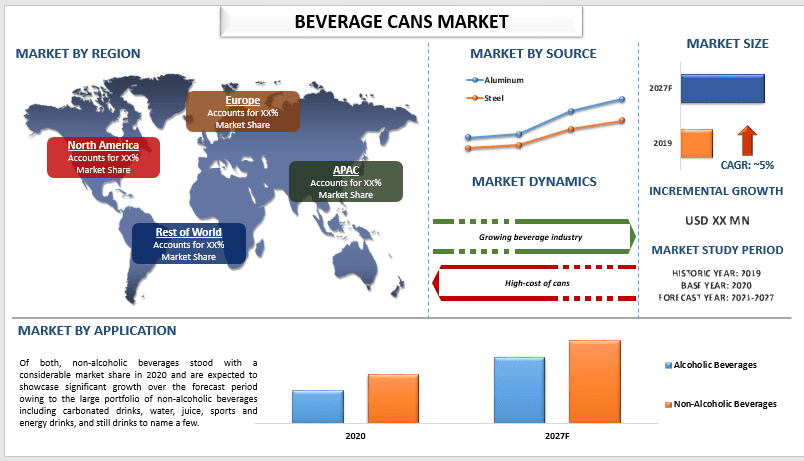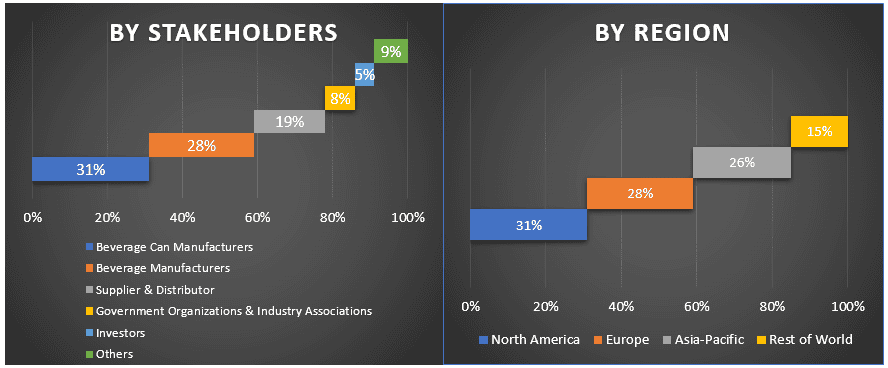- Home
- About Us
- Industry
- Services
- Reading
- Contact Us
Beverage Cans Market: Current Analysis and Forecast (2021-2027)
Emphasis on Material (Aluminum and Steel); Structure (2-Piece Cans, 3-Piece Cans, and Others); Application (Alcoholic Beverages and Non-Alcoholic Beverages); and Region and Country

The global beverage cans market is likely to showcase a growth of around 5% during the forecast period. The global beverage industry is comprised of many drinks including carbonated soft drinks, dilutable, juice, sports & energy drinks, still drinks, bottled water, and alcoholic beverage to name a few. To offer these drinks to the final consumer a range of packaging products are used such as PET bottle, metal can, board carton, board bag in box, glass bottle, and polycarbonate bubble top. PET bottle is the most consumed packaging mainly in non-alcoholic beverages. However, changing consumer preferences i.e., increasing demand for non-plastic packaging and improving income are increasing the market for metal cans. Further, recycling plastic is more complex, leads to degradation, and has lower reuse rates than aluminum. According to the industry association’s data, aluminum cans have on average 73% recycled content – 12 times as much as plastic and 3 times as much as glass. Therefore, as global beverage players are taking several steps to reduce the use of plastic, metal cans can play an important role in this transition.
Insights Presented in the Report
“Amongst materials, aluminum held a prominent share in the market in 2020”
Based on material, the market is categorized into aluminum and steel. Among both, aluminum accounted for a dominating position in the market, and it is expected to retain its position during the forecast period. This can be attributed to its indefinitely recyclable property. Aluminum-based cans are much more efficient to transport, and store compared to steel as they are easy to stack and lightweight. Further, Aluminum cans chill quickly, provide a superior metal canvas for 360-degree labeling and protect flavor and freshness.
“Amongst structure, 2-piece cans accounted for a significant share in 2020”
Based on structure, the market is categorized into 2-piece cans, 3-piece cans, and others. Among these, 2-piece cans are widely consumed in the beverage industry owing to their excellent sealing properties and the fact the manufacturing process particularly suits lightweight aluminum and alloys. These materials have the added advantage of helping beverages cool quickly. Further, since 2-piece cans have fewer seems and therefore a lesser number of weak points. This property makes it the preferred packaging structure for beverage transportation and storage.
“North America accounted for a considerable share in the global beverage cans market”
For a better understanding of the market adoption of Beverage Cans, the market is analyzed based on its worldwide presence in the countries such as North America (The United States, Canada, Rest of North America), Europe (Germany, The UK, France, Italy, Spain, and Rest of Europe), Asia-Pacific (China, Japan, India, Australia, and Rest of APAC), and Rest of World. North America accounted for a significant share in the global beverage cans market and is expected to maintain a prominent position during the forecast period owing to high per-capita consumers of alcoholic and non-alcoholic beverages in the regional countries mainly in the US and Canada. Further, the presence of global beverage leaders in the region like PepsiCo Inc. and The Coca-Cola Company is propelling the growth of the regional market.
Reasons to buy this report:
- The study includes market sizing and forecasting analysis validated by authenticated key industry experts
- The report presents a quick review of overall industry performance at one glance
- The report covers an in-depth analysis of prominent industry peers with a primary focus on key business financials, product portfolio, expansion strategies, and recent developments
- Detailed examination of drivers, restraints, key trends, and opportunities prevailing in the industry
- The study comprehensively covers the market across different segments
- Deep dive country-level analysis of the industry
Customization Options:
The global beverage cans market can further be customized as per the requirement or any other market segment. Besides this, UMI understands that you may have your own business needs, hence feel free to connect with us to get a report that completely suits your requirements.
Table of Content
Research Methodology for Global Beverage Cans Market Analysis (2019-2027)
Analyzing the historical market, estimating the current market, and forecasting the future market of beverage cans, three major steps are undertaken to create and analyze its adoption across the globe. Exhaustive secondary research was conducted to collect the historical market numbers and estimate the current market size. Secondly, to validate these insights, numerous findings and assumptions were taken into consideration. Moreover, exhaustive primary interviews were also conducted, with industry experts across the value chain of the beverage cans industry. Post assumption and validation of market numbers through primary interviews, we employed a bottom-up approach to forecast the complete market size. Thereafter, market breakdown and data triangulation methods were adopted to estimate and analyze the market size of segments and sub-segments of the industry pertains to. Detailed methodology is explained below:
Seek More Details About Research Methodology
Analysis of Historical Market Size
Step 1: In-Depth Study of Secondary Sources:
Detail secondary study was conducted to obtain the historical market size of beverage cans through company internal sources such as annual reports & financial statements, performance presentations, press releases, etc., and external sources including journals, news & articles, government publications, competitor publications, sector reports, third-party database, and other credible publications.
Step 2: Market Segmentation:
After obtaining the historical market size of the beverage cans market, we conducted a detailed secondary analysis to gather current market insights and share for different segments & sub-segments for major regions. The major segment is included in the report by material, structure, and application. Further regional and country-level analyses were conducted to evaluate the overall adoption of beverage cans globally.
Step 3: Factor Analysis:
After acquiring the historical market size of different segments and sub-segments, we conducted a detailed factor analysis to estimate the current market size of beverage cans. Further, we conducted factor analysis using dependent and independent variables such as the rising beverage industry. A thorough analysis was conducted for demand and supply-side scenarios considering an increasing investment, top partnerships, mergers and acquisitions, business expansion, and product launches in the beverage cans industry.
Current Market Size Estimate & Forecast
Current Market Sizing: Based on actionable insights from the above 3 steps, we arrived at the current market size, key players in the global beverage cans market, and market shares of each segment. All the required percentage shares split, and market breakdowns were determined using the above-mentioned secondary approach and were verified through primary interviews.
Estimation & Forecasting: For market estimation and forecast, weights were assigned to different factors including drivers & trends, restraints, and opportunities available for the stakeholders. After analyzing these factors, relevant forecasting techniques i.e., the bottom-up approach were applied to arrive at the market forecast to 2027 for different segments and subsegments across the major regions globally. The research methodology adopted to estimate the market size encompasses:
- The industry’s market size, in terms of value (US$) and the adoption rate of beverage cans across the major markets
- All percentage shares, splits, and breakdowns of market segments and sub-segments
- Key players in the Beverage Cans market. Also, the growth strategies adopted by these players to compete in the fast-growing market.
Market Size and Share Validation
Primary Research: In-depth interviews were conducted with the Key Opinion Leaders (KOLs) including Top Level Executives (CXO/VPs, Sales Head, Marketing Head, Operational Head, Regional Head, Country Head, etc.) across major regions. Primary research findings were then summarized, and statistical analysis was performed to prove the stated hypothesis. Inputs from primary research were consolidated with secondary findings, hence turning information into actionable insights.
Split of Primary Participants by Stakeholders and Regions

Market Engineering
The data triangulation technique was employed to complete the overall market estimation and to arrive at precise statistical numbers for each segment and sub-segment of the global beverage cans market. Data was split into several segments & sub-segments post studying various parameters and trends in the area of material, structure, and application.
The main objective of the Beverage Cans market study
The current & future market trends of global beverage cans were pinpointed in the study. Investors can gain strategic insights to base their discretion for investments on the qualitative and quantitative analysis performed in the study. Current and future market trends would determine the overall attractiveness of the market at a country level, providing a platform for the industrial participant to exploit the untapped market to benefit as a first-mover advantage. Other quantitative goals of the studies include:
- Analyze the current and forecast market size of beverage cans in terms of value (US$). Also, analyze the current and forecast market size of different segments and sub-segments
- Segment in the study include the area of material, structure, and application
- Defined analysis of the regulatory framework for the beverage cans industry
- Analyze the value chain involved with the presence of various intermediaries, along with analyzing customer and competitor behaviors of the industry
- Analyze the current and forecast market size of beverage cans for the major countries
- Major regions/countries analyzed in the report include North America (US, Canada, Rest of North America), Europe (Germany, UK, France, Italy, Spain, Rest of Europe), Asia-Pacific (China, Japan, India, Australia, Rest of Asia-Pacific), and Rest of World
- Company profiles of the beverage cans market players and the growth strategies adopted by them to sustain in the growing market
Deep dive country-level analysis of the industry
Related Reports
Customers who bought this item also bought










